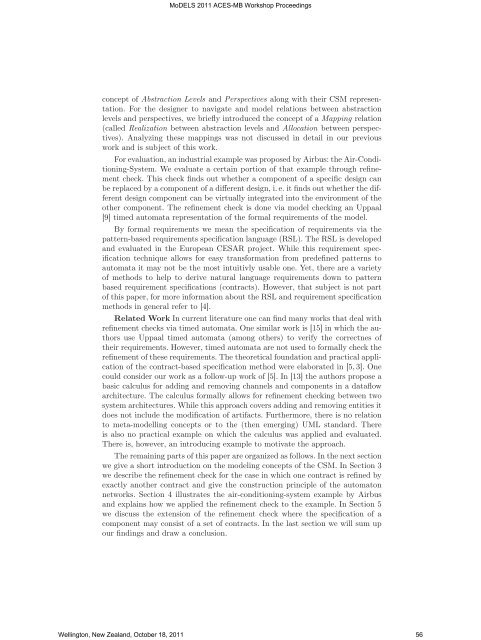A Refinement Checking Technique for Contract-Based Architecture ...
A Refinement Checking Technique for Contract-Based Architecture ...
A Refinement Checking Technique for Contract-Based Architecture ...
Create successful ePaper yourself
Turn your PDF publications into a flip-book with our unique Google optimized e-Paper software.
MoDELS 2011 ACES-MB Workshop Proceedings<br />
concept of Abstraction Levels and Perspectives along with their CSM representation.<br />
For the designer to navigate and model relations between abstraction<br />
levels and perspectives, we briefly introduced the concept of a Mapping relation<br />
(called Realization between abstraction levels and Allocation between perspectives).<br />
Analyzing these mappings was not discussed in detail in our previous<br />
work and is subject of this work.<br />
For evaluation, an industrial example was proposed by Airbus: the Air-Conditioning-System.<br />
We evaluate a certain portion of that example through refinement<br />
check. This check finds out whether a component of a specific design can<br />
be replaced by a component of a different design, i. e. it finds out whether the different<br />
design component can be virtually integrated into the environment of the<br />
other component. The refinement check is done via model checking an Uppaal<br />
[9] timed automata representation of the <strong>for</strong>mal requirements of the model.<br />
By <strong>for</strong>mal requirements we mean the specification of requirements via the<br />
pattern-based requirements specification language (RSL). The RSL is developed<br />
and evaluated in the European CESAR project. While this requirement specification<br />
technique allows <strong>for</strong> easy trans<strong>for</strong>mation from predefined patterns to<br />
automata it may not be the most intuitivly usable one. Yet, there are a variety<br />
of methods to help to derive natural language requirements down to pattern<br />
based requirement specifications (contracts). However, that subject is not part<br />
of this paper, <strong>for</strong> more in<strong>for</strong>mation about the RSL and requirement specification<br />
methods in general refer to [4].<br />
Related Work In current literature one can find many works that deal with<br />
refinement checks via timed automata. One similar work is [15] in which the authors<br />
use Uppaal timed automata (among others) to verify the correctnes of<br />
their requirements. However, timed automata are not used to <strong>for</strong>mally check the<br />
refinement of these requirements. The theoretical foundation and practical application<br />
of the contract-based specification method were elaborated in [5, 3]. One<br />
could consider our work as a follow-up work of [5]. In [13] the authors propose a<br />
basic calculus <strong>for</strong> adding and removing channels and components in a dataflow<br />
architecture. The calculus <strong>for</strong>mally allows <strong>for</strong> refinement checking between two<br />
system architectures. While this approach covers adding and removing entities it<br />
does not include the modification of artifacts. Furthermore, there is no relation<br />
to meta-modelling concepts or to the (then emerging) UML standard. There<br />
is also no practical example on which the calculus was applied and evaluated.<br />
There is, however, an introducing example to motivate the approach.<br />
The remaining parts of this paper are organized as follows. In the next section<br />
we give a short introduction on the modeling concepts of the CSM. In Section 3<br />
we describe the refinement check <strong>for</strong> the case in which one contract is refined by<br />
exactly another contract and give the construction principle of the automaton<br />
networks. Section 4 illustrates the air-conditioning-system example by Airbus<br />
and explains how we applied the refinement check to the example. In Section 5<br />
we discuss the extension of the refinement check where the specification of a<br />
component may consist of a set of contracts. In the last section we will sum up<br />
our findings and draw a conclusion.<br />
Wellington, New Zealand, October 18, 2011 56
















